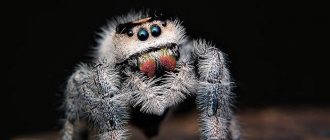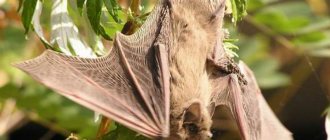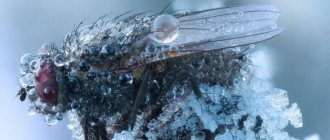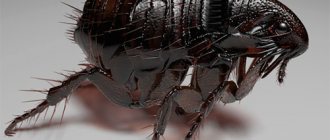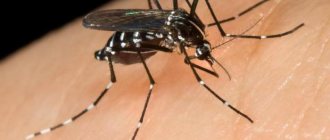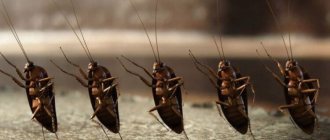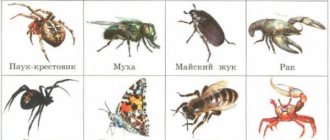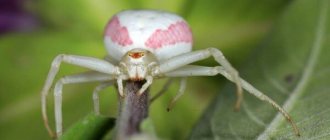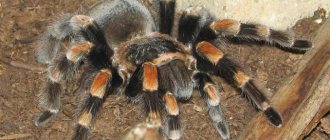House spiders in winter
There is a myth that house spiders become more active in winter, but in fact the opposite is true.
The myth is that spiders move into houses to escape the cold or to find food. However, since spiders do not need to maintain body temperature like warm- and cold-blooded animals, they do not need to hide in warm places or hunt insects for food much because spiders can hibernate, which reduces their energy expenditure. Thus, spiders can live without food for months. Winter does not affect the number of fruit flies, midges, carpet beetles, moths and silverfish in our homes, so even a starved spider waking up from hibernation has the opportunity to survive. House spiders can also feed on their relatives. That is why there are usually no more than three eight-legged neighbors in one house. They can also migrate in a critical situation. If there is absolutely no food, and the spider needs it, it can move either to another part of the house, or outside, to another house.
The only problem for house spiders is the danger of their offspring freezing. Nests often die due to excessive cold. However, spiders often find a solution to this problem using a unique form of web. They can turn it from a trap into a protective cover that will insulate the spiders that have not yet hatched.
Source
Prevention
Let's look at the important points.
The basic rules are cleanliness in the house plus no food. If there are no bedbugs, cockroaches, flies, midges, small bugs, or ants in the home, then the spiders have nothing to eat; they go to other rooms in search of small insects.
Another important rule is cleanliness control. In a bright, spacious, uncluttered home, with timely elimination of leaks, cleaning up crumbs on the floor, and the absence of dark corners where eight-legged creatures and various insects love to hide, hordes of spiders are unlikely to appear. Dust, debris particles, mountains of trash are factors that influence the reproduction of cockroaches, midges, flies, and mosquitoes, which are food for spiders.
Mosquito nets must be intact and fit tightly to the frames: insects can easily penetrate even through small cracks.
If there are a lot of trees near the house, then you need to be more careful, regularly remove cobwebs near the windows, turn on the light in the evening only with the mosquito net closed, if the structure is hinged.
It is important to monitor the condition of window units: situations occur when a plastic window does not close, does not fit tightly to the frame, or scratches surfaces. If the performance characteristics are violated, cracks appear and the mosquito net is damaged, which makes it easier for flying and crawling insects to enter the home.
Spiders in a home, especially in large numbers, are a sign of the appearance of food for eight-legged creatures. It is important to remove small insects, then the arthropods will disappear without problems. Many people have a phobia - the fear of spiders; this factor must also be taken into account. It is important to understand that instead of one small eight-sized creature, many spiders may appear, which makes it much more difficult to remove uninvited guests from the house. It is worth cleaning more often, periodically moving furniture aside, thoroughly cleaning secluded corners, monitoring the integrity of mosquito nets - and creatures that do not belong in a person’s home will live in their natural environment, and not in an apartment.
Sources
- https://vrediteli24.ru/pauki/obychnye-i-bolshie.html
- https://WikiParazit.ru/pauki/vidy-paukov-zhivuschih-doma.html
- https://topotushky.ru/svoimi-rukami/domashnij-pauk-ili-domovoj-komnatnyj-kakie-zhivut-v-kvartirax-raznovidnosti-opisanie.html
- https://obnaruzhil.ru/pauk/pauki-kotorye-zhivut-v-domax.html
- https://GdeKlop.ru/pauki/zavelis-v-kvartire/
- https://buzzbabble.ru/vrediteli/chem-pitayutsya-domashnie-pauki-foto-i-nazvaniya-vidov
- https://365calend.ru/day-omens/animals/pauk-v-dome-narodnye-primety-i-sueveriya.html
- https://combat-dez.ru/pochemu-poyavlyayutsya-pauki-v-kvartire-i-kak-ot-nih-izbavitsya-pri-pomoshhi-himicheskih-i-narodnyh-sredstv/
- https://klopkill.ru/nasekomye/pauki/69-otkuda-berutsja-pauki-v-domah-i-kvartirah-i-kak-ot-nih-mozhno-izbavitsja.html
- https://poryadok-v-dome.com/nasekomye/drugie/pauki.html
[collapse]
What to feed a spider at home: tips for beginners / Press release
There has always been a lot of mysticism and mysteries around these beautiful animals. Even in ancient times, people used spiders in their rituals, attributing magical properties to them. Many people are afraid of them; even just the sight of them gives them goosebumps.
But there are also those who admire the beauty and grace of these animals. Some even keep spiders in their homes. And they even give it as a gift for the holidays! Even many people buy these exotic animals in the form of toys.
But if you decide to get such an unusual pet for yourself, then the first thing you should know about is its proper feeding.
There are basic rules that apply to any type of spider, from the most common tarantulas to the more rare ones. It is necessary to study the topic of feeding so that your pet lives a long and carefree life, does not get sick and pleases its owner.
What to feed your house spider
If we talk about their natural habitat, then spiders are not particularly picky in it. Since spiders are naturally predators, they can feed on absolutely anything they can catch. But when an animal falls into the hands of a person, the choice of “dish” depends only on the owner. Therefore, you will have to carefully plan your pet’s diet and stock up on special food for it. Perfect for spiders:
- various types of cockroaches (but in no case domestic ones);
- mealworms;
- zoophobes.
Feeding food insects is not a troublesome task, you just need to get used to it. You also need to know where you can replenish your pet’s treats.
If you don't want a real exotic animal, consider buying a toy in the shape of this creature. The HANSA toy store offers exotic toy animals. But not only exotic ones, but also others, cute and fluffy.
Forbidden Treats for Spiders
It’s not enough to know what to feed spiders. You also need to be aware of what you absolutely cannot give to them.
For example, many inexperienced owners believe that if a spider is called a tarantula, then it can also be fed with small vertebrates. But, unfortunately, there are many known cases where pets died after such a “feast.” They suffered from simple indigestion. In captivity, a spider can easily overestimate its strength. Therefore, frogs and rodents, like other similar animals, are prohibited.
In addition, such “food” may be stronger than the spider, and it will simply die in an unequal battle. And if he wins, then a whole mouse or frog is a lot even for a large tarantula. He will eat it for more than one day. At this time, the animal will begin to decompose and release toxic venom.
Why is it not recommended to treat spiders to domestic cockroaches? The answer is simple: they can be unhealthy and infect your pet. For the same reason, you should not give insects that you caught on the street yourself. They may be sick or poisoned by poisons or pesticides used on the grass or trees.
What to do if it happens that the food has run out and your pet is very hungry? Then take all precautions and choose areas for catching insects as far as possible from the roadway. It’s better to go outside the city altogether. How can you make sure that the insects you catch are healthy? Ideally, they should be quarantined for a couple of days. But there is often no such opportunity, so you have to take risks. And to avoid having to do this, always check whether you have enough food for your pet.
Varieties
There are three main species of Loxosceles reclusa, as this species of arthropod sounds in Latin.
Brown
The most common variety. They originally lived in Latin America, from where they spread throughout the world since the 70s of the last century. They adapted to the conditions of existence next to humans.
Brown
Chilean subspecies. Less poisonous, common in Chile and Hawaii.
Mediterranean hermit spiders, distinguished by their red-brown or yellowish color, live in the southern latitudes of Europe and Russia. The degree of danger of the poison of this species of arthropod needs additional study.
When to feed the spider
We found out what to feed the spiders. Now you need to figure out how often this needs to be done.
If we are talking about an adult, then the frequency of feeding is about 1-2 times a week. In general, you need to look at your pet’s appetite. If the spider often does not finish what you offer it, then feeding can be done less frequently and the portions can be smaller.
You can watch the animal. As soon as its abdomen increases several times during feeding, this will mean that the pet is full. Leftover food can be removed to prevent overeating. There are cases where spiders ate to such an extent that their abdomen ruptured. Therefore, it is better not to feed your pet.
Young spiderlings, like all children, need to be fed more often, but in smaller portions. Fasting, like overeating, in this case threatens irreparable consequences and major health problems in the future.
Nutrition method
Many people are interested in how spiders eat insects, small vertebrates and other creatures, or rather, how they catch the prey and what they then do with it. Arachnids are known to weave webs from spider webs, which they use for fishing.
The predator itself sits on the central area of the net and waits until it catches an insect. But he determines its presence by the vibration or vibration of the web.
Some species of predators do not spin webs; they explore the surrounding area, wait, and then attack. Others may weave not nets, but funnels near a hole or shelter.
The behavior of predators may differ - some can envelop the prey in a web and wait until it stops moving, others attack it immediately. But initially, a toxic substance is injected into the trapped insect.
Spider nutrition has some features:
- they lack complete digestive organs. The food is digested from the outside, after which the insect absorbs the liquid mass through the mouth.
- Carnivores have no teeth in the oral cavity. They grind food using chelicerae, pedipalps similar to tentacles.
- Some spiders can only suck up liquid food, others crush the shell and bite through the skin.
- Digestion of amphibians and rodents takes longer. The predator eats a mouse, frog, or snake gradually, it turns the victim over, constantly injecting a new portion of saliva.
To eat or not to eat: that is the question
There are times when it is useful for a pack to be on a diet. We are talking about the molting process. This is where your pet will benefit from fasting.
To correctly calculate the days and times of fasting, you can use a simple formula. To do this, keep a notebook and note in it every molt of your pet. Add three to four days to their total number, and you will get the amount of time during which it is better not to feed your spider. Then he will be healthy and will be able to gain strength as soon as possible.
And by the way, if your pet suddenly refuses to eat, you should not immediately sound the alarm. Some individuals can fast for about a month, or even two. There is nothing critical about this.
And don't forget to clean up leftover food after each feeding. Otherwise, they will not only emit an unpleasant odor, but they can also poison your spider if it suddenly decides to taste the remains of its feast.
Cockroach
Domestic cockroaches are the most unpleasant insects that can be found in the house. Scientists claim that they are carriers of infectious diseases that affect the functioning of the intestinal tract. Pests can appear in every housewife, even the cleanest ones; they can sneak into the apartment from neighbors who are undertaking renovations.
Cockroaches feed on everything: food, waste, paper, fabric and much more. They can fast for about two weeks. Not finding food in the house, which is unlikely, they run to the next apartment.
The harm that cockroaches bring to humans:
- They are carriers of infectious diseases.
- They spoil things, get into equipment, feed on wallpaper and paper bindings.
- They can get tangled in the wires and a short circuit may occur, resulting in a fire.
- May cause allergies.
Pests multiply quickly, so experts recommend taking immediate action to destroy them. Pests can be controlled using folk, mechanical and chemical means. The most effective means are chemicals.
- Treat the apartment with a solution of water and vinegar.
- Cockroach crayons. This drug is ineffective in fighting insects, but is not very toxic and is safe for humans.
- Sprays and aerosols. A product with high toxicity, which is not very good for humans. When using an aerosol, do not forget about your own safety; handle the room with gloves and gauze masks.
- Traps. Small and poisonous inside.
- Alcohol. Wipe or spray with ammonia all places in the house where pests live.
- Smoke bombs. The most effective means of pest control and the most dangerous for humans. Smoke is highly toxic. When treating the premises yourself, do not forget about your health and precautions.
Portion volumes and feed preparation
How much food to give at one time? The size of the "food" should not exceed a third of the size of your spider. An insect that is too large can frighten your pet and really get on his nerves.
So that you don’t have to constantly go to the store for a new portion of food, you can prepare it at home. It will be easier and cheaper this way. To do this, you will have to breed mealworms or cockroaches yourself.
Everything is very simple. Take a large jar, pour sawdust and pieces of tree bark into it, and add “residents”. You can feed them scraps from your table. This way you will have fresh and nutritious food for your pet at any time.
Material provided by the online toy store HANSA. If you are interested in spiders, but not real ones, then exotic animal toys will be to your liking!
Source
What to feed your house spider
You can watch a spider's meal for a long time. Feeding spiders is a truly fascinating spectacle. Seeing the victim, the spider rushes at it and instantly injects poison into the body. The poison immobilizes the prey, and the spider, slowly weaving it with a web, releases gastric juice into the prey and begins to eat. The feeding of spiders turns into a whole performance. But what should you feed a regular spider to ensure its long existence? How is feeding a tarantula spider different? To understand what to feed a spider at home, you need to understand what constitutes the diet of arthropods in their natural habitat.
Habitat
In its natural environment, Tegenaria brownie lives among plants and trees. You can find it under bark, fallen leaves, snags, hollows, between tree branches, in the grass. Builds trapping nets near its shelter. The web resembles a funnel, hence the name of the species. However, premises for different purposes are preferable for it. Therefore, it is often called the house spider.
House spider (Tegenaria domestica)
The indoor spider settles in corners, below, above, behind furniture. Weaves a flat triangular web. A funnel leaves from it, from the very center. The owner sits in it. The attic spider can weave everything around, starting from the corners, pumping up beams, windows, walls. One web is connected to another, long threads extend from it, along which the predator moves around the room.
The house spider often settles in cellars, sheds, garages, and utility rooms. Absolutely everywhere where it is not disturbed for a long time. Spawns a web at night; during the day, trapping nets are ready to catch potential victims
The threads sparkle in the sun, attracting the attention of insects
Preparing feed yourself
You can prepare food for your beloved pet yourself. This saves money and time for frequent trips to the pet store. It is not difficult to breed marbled cockroaches, which are a delicacy for spiders in their regular diet. You can grow a colony of cockroaches in a glass jar. You need to throw bark and cardboard at the bottom of the container and put 10-20 individuals there. Marbled cockroaches reproduce quickly and are not picky about food. You can feed them vegetable scraps, bread crumbs and small pieces of meat.
To prevent cockroaches from escaping, you should coat the edges of the jar with Vaseline. When selecting food for a spider’s diet, it is better to collect young cockroaches that have not yet acquired wings. Such victims are suitable for both an adult spider and a small growing pet.
Important tips for feeding spiders:
- You cannot leave the corpse of an insect in the terrarium if decomposition has occurred. Corpse poisons are extremely harmful to your pet.
- Feeding the spider immediately after molting is not advisable. Insects can harm a spider that has just survived its molt.
- It is necessary to immediately remove the remains of the spider's meal.
- It is not advisable to freeze food for further use. Many spiders will simply refuse stale food.
- If the insect turns out to be larger than the spider, you should cut it into pieces.
- If the spider refuses to eat, you need to crush the insect's head with a stone and leave it in the terrarium for a couple of hours. If more than 8 hours have passed and the spider has not touched the food, be sure to remove the corpse.
The key to a long and happy life for your pet is taking care of its diet. Myths that tarantulas should eat only vertebrates cannot be believed. Listening, or rather looking closely at the state of the spider, you need to feed it according to need, and under no circumstances overfeed it. Moderate nutrition, care for the cleanliness of the terrarium and frequent replacement of drinking water are to the taste of all domestic spiders on the planet.
Source
Enclosed spaces
Removing insects in enclosed spaces (greenhouses, apartments, country houses) has its own nuances. There are 7 effective ways to get rid of spiders:
- Aerosol. Since spiders love to settle in corners, you should treat them with an aerosol, and at the same time spray the upper and lower baseboards.
- Chalk or gel. These are cheaper insecticides. They should be used to treat corners and baseboards.
- Wet cleaning with bleach. The smell of bleach will scare away spiders and they will leave the apartment or basement. A rag soaked in a chlorine solution should be walked in the spiders' habitats.
- Vacuum cleaner. Using a vacuum cleaner, you can remove the cobwebs, and the insect will have to look for a new habitat. And the more often you do this, the less chance the insect has of staying in its favorite corner.
- Chlorpyrifos or boric acid. In a room with closed windows and doors, literally everything is sprayed and left closed for 3 hours. After this, ventilate for a long time. This method will not leave any arthropod a chance to survive.
- Repeller. Ultrasonic devices are often used in areas where dangerous animals live. But it can also be used to get rid of spiders. Manufacturers believe that it is harmless to people, so you can buy it in any specialized store.
- Repair materials. Any building material contains chemical components that repel insects. Spiders will not return to the premises until the odors have completely disappeared.
- Mosquito net. To prevent the appearance of insects, it is actively used in the summer.
Where do spiders go in winter?
Arthropods adapt to the onset of cold weather in different ways. Spiders are unable to tolerate temperatures below 0 degrees due to tissue crystallization. Depending on this, spiders can sleep or die in winter.
Young cross spiders and “newborn” wasp spiders migrate on wind-blown spider webs in search of habitat on warm September days. Huddled in a crack in the bark of a tree, spiders sleep in winter.
Sexually mature parents of baby wasps end their life in the summer: the male - in the form of a “wife” dinner after mating, the female - after laying eggs. A similar situation occurs in adult crosses. Autumn is the mating season, when males go in search of females sitting in their web. After fertilization of the female, the male dies. The spider weaves a cocoon in which it lays eggs. Having hidden it in a secluded place (in the bark of trees, cracks in masonry), it also dies. In the spring, spiderlings emerge from the eggs, ready to weave webs.
What do they eat in winter?
Most spiders cannot eat their food right away. The venomous bite is necessary to paralyze the victim and turn its insides into a nutritional cocktail. The peculiarity of spider physiology does not require maintaining a constant temperature. For this reason, they can go without food for a long time and fall asleep, falling into torpor. During the winter months, the food supply is maintained by water and house spiders.
What do house spiders eat in an apartment in winter? Flies and mosquitoes stop penetrating into human housing with the onset of cold weather, going into hibernation. But apartments can be inhabited by cockroaches, moths, and fruit flies. Predators eat each other, thus redistributing habitat areas. The life cycle of house spiders is short: from 2 to 6 months. Reproduction depends on the food supply: if it is insufficient, new offspring appear after the end of the life cycle of the parents.
Danger to humans
Are house spiders dangerous for humans if they take up residence in a house? Small species that enter the house from the street are not dangerous to humans, since they do not emit poison. But if you don’t take action, they will begin to weave cobwebs into the corners of rooms and actively multiply. Arthropods rarely attack humans, but, sensing danger, they can sting. Despite the fact that they are not poisonous, when bitten, a secretion is released from the mouth, which can cause an allergic reaction. In areas with hot climates, black strays are especially dangerous. It is enough to treat the bitten area with an antiseptic.
Preparations for the winter
House spiders, which do not hibernate in winter, surprise with their activity. What can spiders eat in an apartment in winter? If you look closely at the nets they spread, you can see the remains of insects wrapped in webs. The predator prudently creates “storerooms” in cool, damp places, where they can be stored longer without drying out. If there is a “raw material base”, spider stocks are renewed throughout the cold period. The spider withstands long breaks in feeding, supporting itself with water and ceasing active movements.
Source
Routes of entry into human habitation
There are several options for where spiders come from in your home:
- with air currents. The barely hatched spiders, along with the air, enter the apartment through an open window or door;
- on a person or animal. A new neighbor can be brought into the house on clothes, shoes, hair or animal fur;
- cracks. A very small gap in the walls, floor or ceiling is enough;
- ventilation and chimney.
